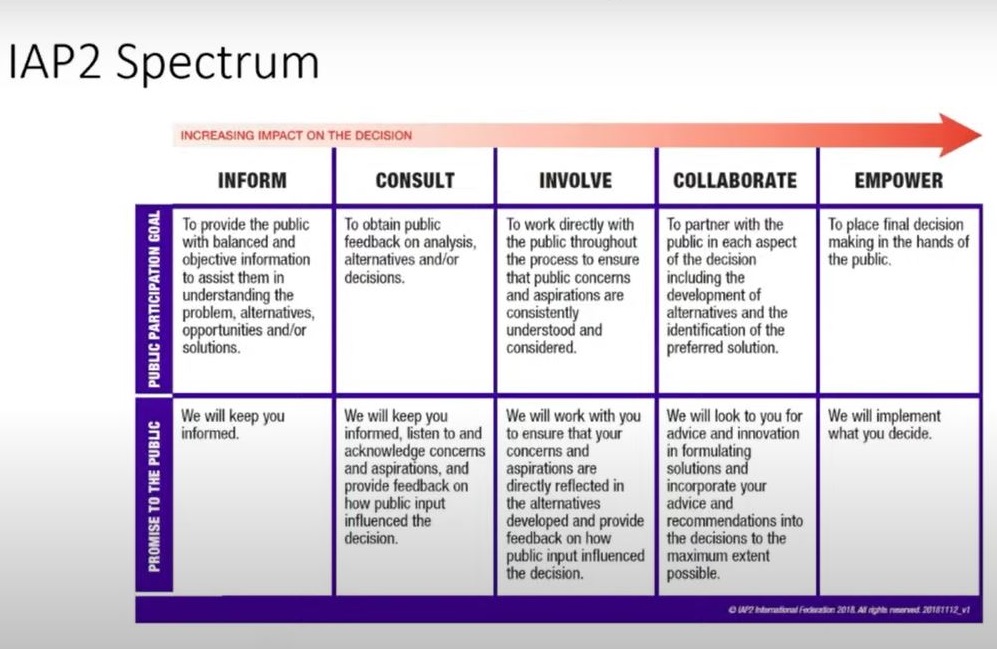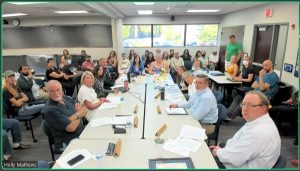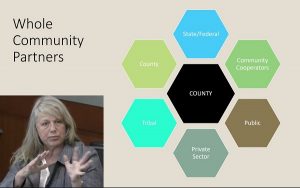City responds to HRNI whistleblower
5 min read
HRNI’s suggestions were implemented in the Middle Housing Code Amendments.
Acting Communications Director Cambra Ward Jacobson (she/her)
by John Quetzalcoatl Murray
The City of Eugene has issued a statement in response to a Human Rights and Neighborhood Involvement whistleblower.
Long-time City of Eugene HRNI employee Rene Kane said she was not allowed to review public engagement plans and tools for the City’s Middle Housing project — despite being identified as a member of the project team.
Rene said she was not consulted when the team designed the “Meeting in a Box,” a new engagement tool designed for neighborhood associations. She later learned that no training was provided to the neighborhoods. Rene asked other City of Eugene employees how many “Meeting In a Box” users successfully shared their opinions.
Just one person, she was told.
Rene made the statements at a City of Eugene public hearing April 18 and at the Neighborhood Leaders Council meeting April 26.
“I was the neighborhood person…and I was never once asked by Planning Staff to weigh in on the Public Engagement Plan, which is required. I actually had to ask for it twice. I asked for it, then my supervisor at the time had to ask for it so I could read it,” Rene said.
Rene said the Planning Team missed an opportunity to build on HRNI’s successful past engagements, in which neighborhood associations helped City staff share information and encourage participation. An earlier neighborhood effort brought in 4,000 responses, she pointed out.
WholeCommunity.News invited the City of Eugene to comment on the whistleblower’s statements. Acting Communications Director Cambra Ward Jacobson provided the following statement:
“The Middle Housing (HB 2001) Code Amendments project was led by the Planning and Development Division and guided by key City partners, including the office of Human Rights and Neighborhood Involvement (HRNI). In the initial stages of the project, City partners met monthly to discuss the project scope, funding, and public involvement approach. The draft Public Involvement Plan was shared with City partners before being presented to the Planning Commission in their role as the Citizen Involvement Committee and was presented for feedback to the City Council. The approved Public Involvement Plan incorporated input from City partners as well as from the City Council and Citizen Involvement Committee. HRNI, along with other City teams, served an important role in the Middle Housing Code Amendments, including providing guidance on the composition and structure of the Equity Round Table and Healthy Democracy panel as well as sharing information for how to reach Neighborhood Associations. HRNI’s suggestions were implemented in the Middle Housing Code Amendments.”
But in bypassing the neighborhoods, Rene Kane says, the City is abandoning the first goal of Oregon’s land use laws.
“Part of the Neighborhood Organization Recognition Policy (NORP) says we have a role in land use in our neighborhoods, and that’s an agreement that has existed since 1976,” she said.
The arrangement goes back to the earliest days of Oregon’s current land use system. Senate Bill 100 was signed into law May 29, 1973 by Gov. Tom McCall, who championed the bill to protect Oregonians from “sagebrush subdivisions, coastal condo-mania, and the ravenous rampages of suburbia.”
The pioneering planning effort emphasized the importance of public involvement. Goal One requires local agencies to meaningfully engage the public in the land use planning process, and requires each city and county to have a citizen involvement program that addresses:
- Opportunities for widespread public involvement
- Effective two-way communication with the public
- The ability for the public to be involved in all phases of the planning process
- Making technical information easy to understand
- Feedback mechanisms for policy-makers to respond to public input, and
- Adequate financial support for public involvement efforts
Rene suggested that by going around the Neighborhood Involvement staff while creating the public engagement plan, the City actually acted to reduce public engagement.
The Middle Housing Public Engagement Plan identifies different levels of engagement for different stakeholders, using a five-level framework provided by the International Association for Public Participation (IAP2): Inform, Consult, Involve, Collaborate, and Empower.
HRNI is listed among Agency Subject Matter Experts whose engagement is to be at the third level, Involve.
The public participation goal at the Involve level: “to work directly with (HRNI) throughout the process to ensure that (HRNI) concerns and aspirations are consistently understood and considered.”
The promise to the public participant at the Involve level: We will work with (HRNI) to ensure that (HRNI) concerns and aspirations are directly reflected in the alternatives developed and provide feedback on how (HRNI) input influenced the decision.
WholeCommunity.News offered the City an opportunity to respond to Rene Kane’s comments and follow-up questions:
- While an explicit goal was to be outcome-oriented (“We will create a community-supported and City adopted land use code amendments”), at the close of the public engagement period, it appears that a majority of the community does NOT support the current plan.
- The explicit values “Careful Planning and Preparation” and “Sustained Engagement and Participatory Culture” suggest Planning should have included Neighborhood Involvement subject matter experts and neighborhood associations in the design, review, and implementation of neighborhood-related public involvement.
- Why did the City take this particular path—excluding the Neighborhood Involvement Liaison from the Middle Housing public involvement planning?
- When the City fails to achieve the outcomes stated in its public involvement plan, how and when is that communicated to Council — and specifically, does Staff tell Council that the public engagement fell short of its goals before the Council vote?
- HRNI is listed as a subject matter expert to be engaged at the IAP2 ‘Involve’ level. Have you heard any dissatisfaction from other listed SMEs about the City having two sets of books: the public engagement plan that is shared with the public, and the internal-only plan that is followed by Staff?
Since receiving the City’s statement, WholeCommunity.News has posed the following additional questions to HRNI:
- What we’ve heard in public hearings and neighborhood meetings is that the HR side of HRNI did some fantastic outreach with the Healthy Democracy folks, but the NI side of HRNI was pretty much neglected or abandoned, compared to previous efforts that used the neighborhood associations to help with outreach and that solicited thousands of participants.
- Can you share numbers of individuals that responded to the Meeting In A Box campaign? Rene Kane says she heard from Staff that while four groups participated, there was only one survey response.
- The City states: “HRNI’s suggestions were implemented in the Middle Housing Code Amendments.” Can you share which suggestions were implemented, and specifically identify suggestions that came from the Neighborhood Involvement (NI) side of HRNI?
Contact John Quetzalcoatl Murray by email or by phone, (541) 632-3692.



